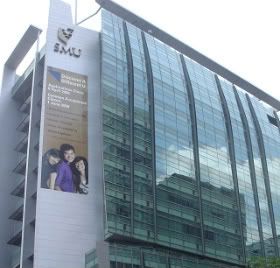Donaldson Tan

Singapore Management University, located at the heart of Singapore's international commerce
“读万卷书,不如行万里路” is a popular Chinese saying. Translated into English, it means “why not travel a thousand miles instead of reading a thousand books.” University students in Singapore are already putting this concept into practice. Recently, the Straits Times reported that “graduate trips are now a rite of passage”.
Budgets for such trips range from S$500 for cheap getaways on budget flights to thousands of dollars for more exotic itineraries. Funding comes from the students’ savings or their incomes from part-time jobs. Surely, cities such as Hanoi, Vientiane and Manila are popular regional destinations because the proliferation of budget airlines has lowered the barrier to regional travel.
Why should such trips be limited to graduation trips and strictly for leisure? While these students regard these trips as their last long vacation with their schoolmates before settling into full-time jobs, such trips are also an affirmation that traveling widens one’s horizons. Local universities are already offering limited travel opportunities through international exchange programs, international internship schemes and summer school. However, these programs are selective (financially and/or academically) and thus only benefit a minority faction among the student population.
During the Fourth Meeting of ASEAN Heads of Government in 1992, ASEAN acknowledged the need to hasten the development of a regional identity and solidarity, and promote human resources development. This is how the ASEAN University Network (AUN) came into existence. Under the auspices of the AUN, faculty and student exchange were established to a limited extent. The main obstacles to greater cooperation among AUN member universities are the incompatability of academic calendars and uneven academic standing.
Considering recent development in regional air transportation, it may be economical for students and faculty staff from ASEAN universities to travel within Southeast Asia more frequently. In another words, the economic barrier for participating in academic and industrial visits by university students and staff to ASEAN member states has been lowered. The School of Law at the Singapore Management University utilised this advantage through the establishment of the Asian Peace-building and Human Rights Programme (APHRP). The APHRP conducts innovative socio-legal research and advises scholars, policy makers and practitioners working to protect and promote peace, human rights and good governance in Asia.
The harmonisation of academic calendars in ASEAN would facilitate more frequent and greater participation (by the student and faculty populace) in inter-university activities without disruption to class schedules. In the case of harmonised academic calendar, every ASEAN university would share the same term break and if a university student club were to organise an international conference during the term break, students from all over ASEAN can fly over to attend the conference on their own expenses. At the same time, local academics can collaborate with their ASEAN counterparts to participate in overseas industry projects.
However, uneven academic standing is a cause of concern for the university administration. This concern manifests itself in the form of an obsession with international university ranking, especially in Singapore. For example, faculty staff are encouraged to publish their research on journals originating from North America and Western Europe and are discouraged to publish on regional research journals. Intra-ASEAN research collaboration is also discouraged because of the relatively low academic standing of ASEAN universities. The low academic standing of ASEAN universities does not incentivise Singapore universities to facilitate cross-university particpation at the student and faculty levels.
Is it even a surprise that the Singapore academic calendars are actually harmonised with North America’s? Yet, do we see a lot of successful research collaboration between Singapore and North American universities? The John Hopkins Incident comes to mind. What was supposed to be joint research collaboration between John Hopkins University (JHU) and the Naitonal University of Singapore on tropical diseases turned out to become a farce – the JHU researchers referred the ‘interesting’ medical cases in Singapore back to the United States.
The issue of uneven academic standing also manifests itself in another way. Due to the relatively advanced academic standing of universities in Singapore, Malaysia and Thailand, faculty development scheme tend to be one-way, ie. only ASEAN university of lower standing send their staff to ASEAN university of higher standing for further professional development. The administration of higher-standing universities must see beyond academic ranking in allocating internal resources. For example, hospitals in Thailand, Malaysia and Vietnam have more advanced referral mechanism than Singapore’s, which make them a more conducive place to conduct medical and drug research on human subjects.
Last but not least, ASEAN is Singapore’s hinterland. The centrality of ASEAN has been advocated not once but multiple times by Singapore’s leaders. At the Public Symposium on Building an East Asian Community held in March 2010, Ambassador-at-large Professor Tommy Koh stressed the central role of ASEAN in the regional institutional architecture. This centrality means nothing if there is no cultural, political and economic connections between Singaporeans and the citizens of othe ASEAN member states.
Singapore Minister of State Grace Fu once remarked that foreign talents bring connections to Singapore businesses. But as long as Singaporean students and faculty staff face administrative barrier to participate in regional cooperation scheme, Singaporeans cannot build up an overseas network of friends and collaborators for business and personal agenda as students. It appears that we Singaporeans will continue to depend on foreign talents for international connections for commerce in the forseeable future.


Come to Laos Sing UNI undergrads and grads.
Learn, experience, teach and enrich yourself.
Sub-EDIT, TEACH AND WRITE FOR Lao English-French newspaper, KPL News, Vientiane.
I am doing that and for the last two years.
Come on your own and support yourself.
It is a great experience.
You can connect with the local U too if you want, NUOL.
I have learnt a lot during my stay of seven years in this country.
contact me. email.
Thanks for this great post on thailand solidarity, I was searching for something along the lines of this and in the top 20 results at google, yours was the most informed and well presented. I was wondering, do you think Thai Culture would make a great topic for a future post here? Or did you do that already?